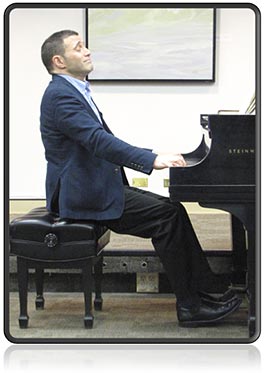Music Educators Association of New Jersey
Serving teachers and students since 1927



Adam Kent, a favorite MEA lecture/recitalist, performed and discussed Grieg's Lyric Pieces at our May 19th General Meeting. It was a great pleasure to welcome Adam back to an MEA meeting.

Edvard Grieg is considered a Post-Romantic composer analogous to Tchaikovsky and Dvorak, and his nationalism added a new dimension to the Romantics' harmonic language and points the way to Debussy. Fortunately for us, Grieg left recordings of his own works on cylinders and piano rolls. From these we can hear the performing styles at the time of his death in 1907. [One may hear Grieg playing Butterfly via a 1906 piano roll on the Wikipedia webpage "Lyric Pieces".] Edvard Grieg was celebrated in Norway and headed musical societies. Yet, he was frail, five feet tall, and suffered from life-long respiratory problems.

Grieg's 66 Lyric Pieces are his most widely known compositions for solo piano, published in ten volumes starting in 1867 while he lived in Copenhagen. To complete the cycle, Grieg transferred the melody of his first piece, Arietta (Book 1, Op. 12, No. 1, 1867), into a waltz in his last piece, Remembrances (Book 10, Op. 71, No. 7, 1901). Wedding Day at Troldhaugen (Book 8, Op. 65, No. 6, 1896), is programmatic. It tells a story of a procession in which one can hear a mingling of harmonics, country fiddling, open fifths, bell-like sounds, shaping of chords such as a triad plus a sixth leaning toward pentatonicism - all typical of Grieg's music.
To further demonstrate open fifths, Adam performed Bell Ringing (Book 5, Op. 54, No. 6, 1891). He declared this was a futuristic piece, a mixing of major and minor together in harmonies anticipating Ravel and Debussy. Although Grieg orchestrated some of his Lyric Pieces, someone else orchestrated this work.

Grieg's summer home, Troldhaugen (Valley of the Trolls), six miles from Bergen, Norway, has Grieg's Steinway piano from 1892. The property includes a hut by a lake, which was the composer's workroom. In glorifying the outdoors, Grieg sometimes evokes natural imagery. In The Butterfly (Book 3, Op. 43, No. 1, 1886), Grieg seeks to illustrate the capriciousness and elusiveness of the butterfly by techniques such as phrases which reach a stable chord - root position chord - only at the ends of phrases. He uses the third of the chord in the bass. At the outset, what is the tonic? Phrase lengths are irregular - 6, 9, or 7 bars long. There is unpredictability in keys: is this section in E Major or G Major? There is a magic of voice leading and chromatic freshness.

Little Brook (Book 7, Op. 62, No. 4, 1895), leaves an impression of the spontaneous call of birds. The middle section suggests Debussy's Claire de Lune. (These two pieces were published within a few years of one another.) The Notturno (Book 5, Op. 54, No. 4, 1891) also uses imitations of bird song, a Schumannesque pulsating inner movement, and a motive similar to Claire de Lune in its middle section. Grieg's Piano Concerto Op. 16 is an early work about which he and Franz Liszt discussed orchestration. Grieg's Cello Concerto Op. 36, written for his brother, is based on the same main theme as his Piano Concerto.
Another processional piece, Homeward (Book 7, Op. 62, No. 6, 1895), illustrates syncopation, open 5ths, chromatic mediants (chords a third apart), leading tones which do not resolve up to the tonic, modality (the raised fourth note of Lydian inflexion). Not only Norwegian or Polish composers (Chopin), but European composers universally used Lydian mode to sound folkloric. Halling, named after a Norwegian folk dance, uses the rhythm of the last movement of Grieg's Piano Concerto, and, since it is difficult to make a diatonic instrument like the piano sound like the twang and microtones of a string folk instrument, Lydian mode.

Grieg wrote a few longer pieces: the E minor Sonata Op. 7 and Ballade in G minor Op. 24 sometimes called Variations on a Norwegian Mountain Melody. There is a recording of Grieg playing the Ballade in which one can hear him playing the rhythm of duplets versus triplets by swinging the duplets to match the triplets. Grieg assimilated Baroque notation for this interpretation. Because Grieg wrote this piece in 1875-76 when both his parents died and he had marital problems, he found it too emotional to perform in public. He used Norwegian melodies, what he called "northland peasantry," to show that life up north can be happy and gay. The main theme's tune has lots of interval repetition so he uses polyphony to smooth over the repetitiveness. Although the Ballade is in G minor, one variation has the tune in D-flat and one is in G Major in augmented rhythm.
Adam Kent gave us well-researched insights into Grieg's solo piano works enlivened by his talented performance of the pieces. Once again, we must thank him for a truly professional presentation.

Photos and layout, Nancy Modell
Beverly Shea, Hostess and writer